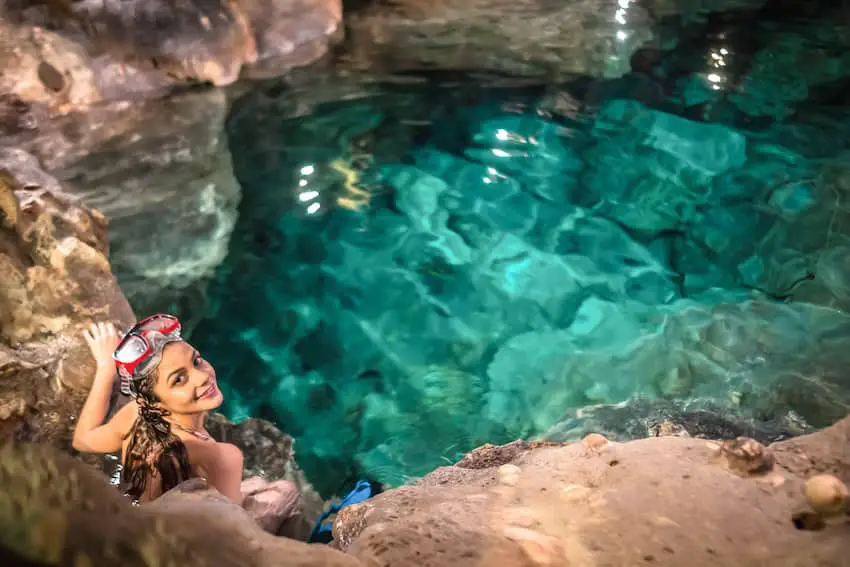The capital of Yucatán state and the largest city in Mexico’s southeast, draws visitors for its rich cultural heritage, stunning colonial architecture, and proximity to Maya ruins such as Uxmal. More than history, Mérida is near a number of cenotes that deserve to be visited.
These natural limestone sinkholes, filled with clear freshwater, offer a chance to dive into the geological and cultural history of the Yucatán Peninsula. This article will take a look at the cenotes near Mérida and offer a guide on this unique way to beat the Yucatecan heat.

How to visit
You can go it alone and try to explore the cenotes through your own wits and gumption. Though the joy of leading your own adventure may be offset by the difficulties in finding cenotes in the vast jungle, where GPS can often falter.
Another option is to find a guide in a town in a cenote-rich area like Homúl. Roadside guides will jump to their feet the moment they see your car approaching town, waving a laminated offer sheet with prices. If you choose to stop, prepare to negotiate price and number of cenotes to visit.
Personally, I’ve had better luck ignoring the aggressive guides on the outskirts. I prefer driving into town and asking a shopkeeper if they know anyone who can show me around. I’ve made much better connections with honest, personable locals who are happy to while away an afternoon showing off their favorite local spots.
If you have the resources, you can go the luxe route and find a local tour agency that can arrange everything for you, up to and including transportation to the site, private, guided tours, food and the pleasure of enjoying your own personal cenote. There are also a number of haciendas that feature cenotes on their grounds, offering the visitor the chance for a truly private, luxury escape.

Fact and fiction
Plenty of rumors swirl around the cenotes. Locals like to warn you to be careful when swimming, as there are dangerous currents that connect the cenotes and can drag the hapless swimmer under. It’s a scary thought, but one with little basis in reality: the flat Yucatán plain has none of the steep elevation changes necessary to form a current.
Another rumor, likely promulgated by local guides, is that the water in the cenotes has elevated levels of calcium, which makes swimming more difficult and necessitates the use of life jackets. Although there are higher levels of calcium in the water in Yucatán, this has no effect on a swimmer’s buoyancy.
In all likelihood, these and other rumors spread with the good-hearted intention of keeping swimmers safe. Though there have certainly been drowning incidents in cenotes, the reasons are the same as those at a public swimming pool: head injury, panic, swimmer fatigue and visitors simply misjudging their abilities in the water. Though they may feel infantilizing, lifejacket rules enable more people to enjoy the cenotes, so wear yours and respect the local rules.
Top cenotes to explore near Mérida
Cenote Xlacah
Located at the Dzibilchaltun archaeological site, Cenote Xlacah is one of the most accessible and historically significant cenotes near Mérida. This open cenote, whose name means “old village” in Mayan, is perfect for a refreshing swim after exploring the nearby ruins. The clear, shallow waters make it ideal for families and those new to cenote swimming.

Cenote Yokdzonot
About 18 kilometers from Chichén Itzá, Cenote Yokdzonot is a less well-known cenote managed by a cooperative from the local community of the same name. This cenote offers a more tranquil experience compared to the often crowded cenotes near major tourist attractions. The community’s eco-friendly initiatives ensure the cenote is well-preserved and pristine.
Cenotes of Cuzamá
This trio of cenotes in the town of Cuzamá — Chelentun, Chansinic’che and Bolonchoojol — are accessible by traditional horse-drawn carts. Each cenote offers a unique experience, from the crystal-clear waters of Chelentun to the dramatic light beams filtering into Bolonchoojol. The journey to the sites is an adventure in itself, traveling through the jungle in your cart with birds screeching above and mosquitos whining below.
Cenote San Ignacio

Unlike many other cenotes, the Cenote San Ignacio in Chocholá is entirely underground, creating an intimate and otherworldly atmosphere. The cenote is well-lit, allowing you to fully appreciate the stunning stalactites and stalagmites that adorn the cave. Aboveground, the site also offers amenities such as a restaurant and hammocks for lounging.
Cenote Kankirixche
Cenote Kankirixche is a stunning, larger cenote whose name means “tree of yellow fruit” in Maya. Located in Abalá, the cenote features a large cavern with beautiful stalactites and crystal-clear waters. Its relative seclusion ensures a peaceful and immersive experience, making it a favorite among those looking to escape the crowds and connect with nature.
Whatever your reasons for visiting the Mérida region, the cenotes are an essential addition to any trip, offering the visitor a journey into the heart of Yucatán’s natural and cultural heritage. From the historically significant Xlacah to the tranquil waters of Yokdzonot, each cenote offers a bewitching experience. And hey, if you are pressed for time, at least stop by Mérida’s Costco, where in the parking lot you can take a look at Ka Kutzal: the world’s only cenote in a parking lot.
Stewart Merritt is a professor and freelance writer based in Mérida. A native of California, he has been visiting Mexico his entire life, especially the Pacific coast, where he likes to surf. This summer he will marry his Yucatecan fiancé.
